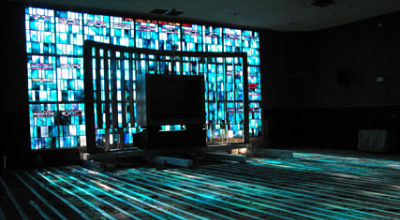Churches, Synagogues Press for Federal Rebuilding Aid After Sandy
The cornerstone of West End Temple reads “1960,” but the interior of the synagogue in New York City’s Rockaway Beach neighborhood looks like a construction zone—walls and floors gutted down to the wooden studs, bathroom fixtures gone, warped pews piled in the banquet hall.
The synagogue is being dried out after Superstorm Sandy pushed four feet of water into the building from nearby Jamaica Bay.
The Reform congregation has applied for a rebuilding grant from the Federal Emergency Management Agency, but the $51 billion disaster aid package to be considered by Congress next week doesn’t specifically include houses of worship on the list of eligible nonprofits.
Civil liberties groups—and even some religious organizations—think that’s the way it should stay because of the constitutional separation of church and state. Others believe it’s discriminatory not to include institutions that often provide essential community services.
At West End, a flood insurance payout, an online fundraising campaign and donations are only a start for a rebuilding project that’s expected to reach well over $1 million. “I don’t know how we are going to afford it,” said Rabbi Marjorie Slome, stressing that the cleanup is costing $130,000, and the congregation is just beginning to assess the total cost.
The temple usually hosts a 75-student nursery school, parent/toddler drop-in center and a variety of groups such as Alcoholics Anonymous and the Boy Scouts. “There is a not a person in this community who does not want this place up and running,” said neighbor Ariana David, with tears in her eyes, as she stopped by to see the rabbi.
Even with their good works, religious institutions “would say this is primarily our sacred space,” which is precisely why they should not be added to the Sandy aid bill, said the Rev. Barry Lynn, executive director of Americans United for Separation of Church and State.
“It’s very difficult to figure what percentage (of a building) is secular and what percentage is religious,” he said in an interview. “Once you use tax dollars to pay for the bricks and mortar, you go off the constitutional cliff.”
Essentially, taxpayers would be compelled to support a religion, which “undermines the fundamental religious liberty protections in the First Amendment (of the U.S. Constitution),” said Dena Sher, legislative counsel for the American Civil Liberties Union.
Other organizations don’t see a constitutional conflict. There are precedents for government grants to religious organizations, said Nathan J. Diament, executive director of public policy at the Orthodox Union’s Institute for Public Affairs, which represents Orthodox Judaism.
“The Department of the Interior distributes grants to restore historic buildings, which several years ago included the Old North Church in Boston, still a functioning Christian church,” he noted.
The Orthodox Union is working with Obama administration officials to get clarification on the FEMA grant issue, he said, adding that about 40 New York synagogues and a dozen New Jersey synagogues have applied or are expected to apply for grants.
Before the new Congress was sworn in on Jan. 3, retiring Sen. Joseph Lieberman, I-Conn., added two amendments that would have included houses of worship in the aid bill, but the amendments were dropped on unrelated procedural grounds.
Other groups supporting the Lieberman amendments are the Jewish Federations of North America, the U.S. Conference of Catholic Bishops and the American Jewish Committee.
Catholic churches “provide a huge amount of social services — soup kitchens, food pantries, housing for the poor,” said Sister Mary Ann Walsh, spokeswoman for the Catholic bishops. “If you need a roof, you need a roof. It has nothing to do with the doctrine of the Trinity,” she said in an interview.
Nevertheless, said the Anti-Defamation League, “houses of worship are special—not like other nonprofits and not like other buildings. They receive special constitutional protections from government interference, special tax-exempt benefits for contributions, and have special restrictions that prohibit direct public funding.”
In a statement, the ADL said “government bureaucrats making funding allocation decisions about which storm damage to cover—and in what amounts—may not be neutral, and may well make decisions on the basis of favored or majority religions.”
Both Slome and the ADL agreed on at least one thing: Sandy’s fury didn’t discriminate. And as Slome sees it, neither should the government.
“I feel this should be treated like a fire or a burglary. The fire department doesn’t stop fighting a fire if it’s the synagogue,” she said. “I don’t see this as a foot in the door for funding for my religious schools.”
Copyright 2013 Religion News Service. All rights reserved. No part of this transmission may be distributed or reproduced without written permission.














































